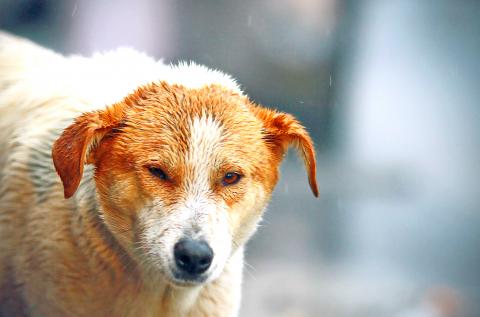Think of all the dogs out there: Labradors and poodles and labradoodles; huskies and westies and dogues de Bordeaux; pit bulls and spaniels and lovable mutts that go to doggy day care.
Add them up, all the pet dogs on the planet, and you get about 250 million.
But there are about 1 billion dogs on Earth, according to some estimates. The other 750 million don’t have flea collars. And they certainly do not have humans who take them for walks and pick up their feces. They are called village dogs, street dogs and free-breeding dogs, among other things, and they haunt the garbage dumps and neighborhoods of most of the world.

Photo: EPA/Nic Bothma
THE MEANING OF DOG
In their new book, What Is a Dog?, Raymond and Lorna Coppinger argue that if you really want to understand the nature of dogs, you need to know these other animals. The vast majority are not strays or lost pets, the Coppingers say, but rather superbly adapted scavengers — the closest living things to the dogs that first emerged thousands of years ago.
Other scientists disagree about the genetics of the dogs, but acknowledge that three-quarters of a billion dogs are well worth studying.
The Coppingers have been major figures in canine science for decades. Raymond Coppinger was one of the founding professors at Hampshire College in Amherst, and he and Lorna, a biologist and science writer, have done groundbreaking work on sled dogs, herding dogs, sheep-guarding dogs and the origin and evolution of dogs.
“We’ve done everything together,” he said recently as they sat on the porch of the house they built, set on about 100 acres of land, and talked at length about dogs, village and otherwise, and the roots of their deep interest in the animals.
Both had dogs as children. Lorna had several kinds. An uncle brought Raymond his first dog, a pup from a female that hung around a loading ramp at a chemical plant in Cambridge, Massachusetts. “He lived to be 17 — he looked like any other village dog in the world,” he said.
After they graduated from Boston University, where they were both undergraduates in the late 1950s, they continued to keep them.
“I gave her a dog for a graduation present,” Coppinger said. It was reputedly a collie-shepherd mix.
After they both graduated, they moved to the Amherst area, where Lorna taught Russian and received a master’s degree in wildlife biology and Raymond pursued a PhD in zoology, both at the University of Massachusetts. They did field studies together, but on different subjects, and then dove deeply into the canine world.
CHALLENGING SCIENCE
In 2001, their book Dogs: A Startling New Understanding of Canine Origin, Behavior & Evolution challenged the way scientists thought about the beginnings of dogs.
They argued against the widely held view that one day a hunter-gatherer grabbed a wolf pup from a den and started a breeding program. Instead, they argued, dogs domesticated themselves.
Some wild canines started hanging around humans for their leftovers and gradually evolved into scavengers dependent on humans. Not everyone in canine science shares that view today, but many researchers think it is the most plausible route to domestication.
During their travels over the years — to look for sheepdogs, to introduce them to sheep farmers who had not used dogs, to attend conferences — they noticed dogs in the street wherever they went, and after a while they began to think about the dogs’ lives.
Raymond Coppinger said he was once told by a Navajo sheep herder that a good herding dog was “not too big and not too small,” which perfectly describes village dogs, too. They are larger in colder climates, but in the tropics, he said, a 30-pound, lion-colored dog is the norm.
They are completely polygamous. “There can be as many fathers to a litter of puppies as there are puppies to a litter,” Raymond Coppinger said.
And after about 10 weeks, the puppies fend for themselves. Most of the pups don’t survive, as is the case with many wild animals.
They have remarkably varied connections to human beings. Some live completely on their own at dumps. Some are neighborhood dogs, recognized and perhaps given handouts by people who live in a certain area. Others may feed and breed on their own, but spend nights at the homes of people.
Sometimes they are adopted by people. But really, Coppinger says, it is the dogs who adopt humans.
WHY WOLVES AREN’T DOGS
The Coppingers were joined for the recent conversation at their home by Kathryn Lord, a former student of Raymond Coppinger and now a researcher at Hampshire College, who studies the development and reproductive behavior of dogs, including village dogs.
She shared her insights on what makes a dog a dog, and not a wolf, for example. Wolf puppies depend on their parents and other adults regurgitating partly digested food.
“This is all but lost in dogs,” she said. It does happen, but reports suggest that in village dogs it may occur several times a week.
The point the Coppingers and Lord make about these behaviors is not that dogs are somehow less caring or noble than wolves, but how perfectly adapted they are to the lives they lead.
They don’t need to be big and strong to bring down prey. They don’t need the kind of parental care and hunting instruction that wolf pups get. As Lord said, dog pups don’t need to catch and kill anything. “They need to walk up to a rotten melon and eat it, which they can do at 10 weeks.”
Puppies, after they are weaned, cannot compete with adults, so unless disease or dogcatchers have put a dent in the adult population, most of them starve.
They have a true superpower in reserve, however, that can help them escape their fate: They can convince a human to feed them.
Raymond Coppinger recalled a woman in South Africa who had many dogs in and around her house. He asked her how it happened that she had so many dogs. “I don’t know,” he recalled the woman saying. “They just keep coming.”
But what are village dogs? Are they a breed, or a superbreed apart? Or are they just a mixture of many breeds with origins too messy to trace?
Adam Boyko, a biologist at the Cornell University College of Veterinary Medicine, who was inspired to pursue canine science by the Coppingers’ 2001 book, has also compiled DNA from village dogs around the world. One of his research papers concluded that village dogs in Mongolia are at the center of dog diversity. That suggests that they are geographically nearest to the place where dogs first evolved.
Other evidence has suggested that dogs originated in Europe or China, however, and Boyko is one of a number of participants in a major study being led by Greger Larson at Oxford to use ancient DNA and fossils to clear up some of the confusion about the origins of dogs.
And other village dogs seem to have different genetic makeup. For example, Boyko and his colleagues analyzed DNA samples from village dogs on remote islands in Fiji and French Polynesia that he hoped would show a historical pattern of migration as people and their dogs moved from place to place.
“Almost without exception the dogs were 99 percent European,” he said, meaning their ancestors were dogs on European ships that came to Pacific islands ages ago. Dogs in other places, like Borneo, he said, show almost no trace of European breeds.
Raymond Coppinger has suggested that dogs evolved after the invention of agriculture, perhaps around 8,000 years ago, and that today’s village dogs are the closest to these first dogs. But this idea has little support from other scientists.
The Coppingers’ main goal is to draw attention to the world’s vast majority of dogs that are hidden in plain sight. They represent a treasure trove of scientific information.
Although the Coppingers recognize the social cost of animals that are unvaccinated and running free, they argue that killing the dogs, as some countries do during rabies epidemics, does not help. It is impossible to kill them all, and because they breed rapidly, the population quickly rebounds.
Nor do the Coppingers have any sympathy for rescue groups that, as Raymond Coppinger puts it, “kidnap and mutilate” street dogs from the Caribbean and elsewhere to bring them to American shelters to live as pets, “where they are made totally dependent and entirely restricted.” This is supposed to benefit the dogs, but Coppinger argues that they are taken from a rich social environment, with many dogs, to lives of relative isolation.
What to do? The Coppingers suggest a simple answer. One way or another village dogs depend on garbage. If society wants fewer dogs in the street, there is a surefire solution.
Less garbage.

On Jan. 17, Beijing announced that it would allow residents of Shanghai and Fujian Province to visit Taiwan. The two sides are still working out the details. President William Lai (賴清德) has been promoting cross-strait tourism, perhaps to soften the People’s Republic of China’s (PRC) attitudes, perhaps as a sop to international and local opinion leaders. Likely the latter, since many observers understand that the twin drivers of cross-strait tourism — the belief that Chinese tourists will bring money into Taiwan, and the belief that tourism will create better relations — are both false. CHINESE TOURISM PIPE DREAM Back in July

Taiwan doesn’t have a lot of railways, but its network has plenty of history. The government-owned entity that last year became the Taiwan Railway Corp (TRC) has been operating trains since 1891. During the 1895-1945 period of Japanese rule, the colonial government made huge investments in rail infrastructure. The northern port city of Keelung was connected to Kaohsiung in the south. New lines appeared in Pingtung, Yilan and the Hualien-Taitung region. Railway enthusiasts exploring Taiwan will find plenty to amuse themselves. Taipei will soon gain its second rail-themed museum. Elsewhere there’s a number of endearing branch lines and rolling-stock collections, some

Could Taiwan’s democracy be at risk? There is a lot of apocalyptic commentary right now suggesting that this is the case, but it is always a conspiracy by the other guys — our side is firmly on the side of protecting democracy and always has been, unlike them! The situation is nowhere near that bleak — yet. The concern is that the power struggle between the opposition Chinese Nationalist Party (KMT) and their now effectively pan-blue allies the Taiwan People’s Party (TPP) and the ruling Democratic Progressive Party (DPP) intensifies to the point where democratic functions start to break down. Both

This was not supposed to be an election year. The local media is billing it as the “2025 great recall era” (2025大罷免時代) or the “2025 great recall wave” (2025大罷免潮), with many now just shortening it to “great recall.” As of this writing the number of campaigns that have submitted the requisite one percent of eligible voters signatures in legislative districts is 51 — 35 targeting Chinese Nationalist Party (KMT) caucus lawmakers and 16 targeting Democratic Progressive Party (DPP) lawmakers. The pan-green side has more as they started earlier. Many recall campaigns are billing themselves as “Winter Bluebirds” after the “Bluebird Action”